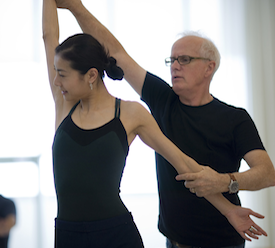
“The more you have done, the harder it is to find music,” said Helgi Tomasson. He should know; Caprice, premiering April 4 at the War Memorial Opera House, is the newest of the more than 40 ballets he’s created in his lifetime. Most of them, of course, were for the San Francisco Ballet, where Tomasson, 71, has been artistic director for 29 years — and he just renewed his contract, he said during a recent chat, for five years more.
“When you’re young at it, you say, I’d like to use this or that. Now, it’s more likely to be too similar to what I used before.” So, new creations can be driven by necessity — the dancers are waiting in the studio, and I have to give them something to do, as Paul Taylor once put it — but how they come together is driven by the music.
“I’ve been sort of fascinated by Saint-Saens. I chose Saint-Saens’ Second Symphony, because it’s dancy. It’s very well-suited to the neoclassical style, which I do, and not terribly well-known, even to Martin [West], my music director,” Tomasson said. “It has a very short adagio, so I felt I needed to add something else to it, so I used all of the Second Symphony and added the Adagio from his Third Symphony,” known as the ‘Organ’ Symphony. This could have posed a problem, since the San Francisco Ballet has no organ. But Tomasson had once heard it on the radio, arranged for brass. “I spoke to Martin about it,” and the music director thought it was possible. Tomasson said he didn’t expect to hear the new arrangement until a couple of days before Caprice’s premiere.
Meanwhile, he focused on the dancing. “It started with the long adagio, so I thought, why don’t I have two couples, and split it up, and then bring them both back together.” To originate the roles, Tomasson chose Yuan Yuan Tan and Luke Ingham as one couple, and Maria Kochetkova and Vitor Luiz as the other. The two ballerinas can inspire a study in contrasts. “Yuan Yuan is beautiful and lyrical. Her fluidity is remarkable. Masha [Kochetkova’s nickname] also can be lyrical, but we tend to see her in fast-moving things. Here, we’ll be using both qualities.” Their partners are correspondingly different as well. Ingham’s a tall, classically elegant Australian who joined the company as a soloist in 2012 from the Houston Ballet and has danced all principal roles; Luiz, a Brazilian wizard of pyrotechnics, joined as a principal dancer from the Rio Municipal Ballet in 2009.
New creations can be driven by necessity ... but how they come together is driven by the music.
Since it’s an orchestral piece, Tomasson felt he needed a corps of five or six pairs of men and women to accent the choreography. “At first I thought I would have a much bigger corps, and three extra men, but then you find out the music didn’t lend itself to them. And to move a bigger group of people around is a lot harder.”
When he sets foot in the studio to begin making a new ballet, Tomasson never brings steps, nor does he know anyone who does, as early choreographers did. “I might have an idea for that particular phrase, I might like them to come in on that phrase, and once they get there I decide what they’ll do.” Sometimes it works; sometimes something else works better, “so then they do it like that. Unconsciously, they are contributing to me as a choreographer.”
Tomasson’s created more than 40 ballets, most of them for his own company. Simultaneously, he’s taken San Francisco Ballet to global renown. This summer, the company has been invited to the Theatre du Chatelet in Paris, July 18-26, as part of Les Étés de la Danse’s (Summers of Dance) 10th anniversary celebration, “Because we brought them such good luck,” he said, as the first company to participate.
“You’re always learning, and you pass on what your experience has been. As you mature and go into different roles, you learn about yourself and about the roles.” -Helgi Tomasson, artistic director, San Francisco Ballet
Tomasson marked 29 years at the helm by signing a contract earlier this month for another five years as artistic director. And beyond doing what he’s doing, he hasn’t thought about what comes next. “I’m sure when the time comes, there are going to be quite a lot of people interested, but I have quite a few years yet.” He’s busy, he said, seven days a week. “I have a wonderful staff of ballet masters and mistresses, and they get assigned to learn the work. And maybe I will oversee, keep an eye on everything.”
If something unforeseen arises, “You just deal with it, you have to solve it,” he said. “You can’t just throw your hands up and say well, I’m leaving. There’s always something. Sicknesses, injuries, can they get out of that rehearsal…’’
Tomasson stays trim, he said, by teaching class, rehearsing the dancers, and walking his Pacific Heights neighborhood. He and his wife, Marlene, still have a home in the Napa Valley, but now there’s no time to make wine from their grapes.
It’s never easy for choreographers or artistic directors to talk about what they do, and less so if, like Tomasson, they’re modest and quiet. But when he discusses how dancers grow, it’s possible to extrapolate from the dancer (he was a brilliant one for 15 years at the New York City Ballet), to the choreographer, and thence the artistic director. “You’re always learning, and you pass on what your experience has been,” he said. “It’s a creative process and they all strive for perfection. As you mature and go into different roles, you learn about yourself and about the roles. You’re always learning things you can do now that you couldn’t do before.
“I don’t think any dancer stops learning, ever.”
